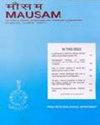全球季风:概念和对人为变暖的动态响应
IF 0.7
4区 地球科学
Q4 METEOROLOGY & ATMOSPHERIC SCIENCES
引用次数: 2
摘要
几个世纪以来,人们一直在研究季风,但直到最近,区域季风才被认为是一个全球系统。本文首先回顾了全球季风的概念及相关的争论问题。我们认为,GM驱动了哈德利环流、热带辐合带、副热带高压和干旱气候区域的年周期。陆地季风降雨(LMR)为世界上约70%的人口提供了水资源。在这里,我们回顾了参与耦合模型相互比较项目(CMIP6)第六阶段的模型预测的全球和区域LMR对人为变暖的气候敏感性,重点关注导致预测变化的关键物理过程。理论上,区域平均LMR变化可以通过对流层中部上升和850百帕比湿度的乘积变化,加上蒸发的适度贡献来近似。温室气体(GHGs)的强制作用增加了水分含量,但稳定了大气;这两种热力学效应相互抵消,导致LMR受到适度的热力学影响。温室气体引起的水平差异变暖导致了强劲的“北半球(NH)比南半球(SH)温暖”、“陆地比海洋温暖”和类似厄尔尼诺现象的变暖模式。增强的NH-SH热对比将增加NH季风降雨量,减少SH季风降雨量。陆地-海洋热对比的增强将增加亚洲-北非季风区的季风降雨量。预计东太平洋变暖将减少北美季风。模型间扩散分析表明,温室气体引起的环流变化(动态效应)是造成区域差异的主要原因。最后一节讨论了可以设想的前进道路。本文章由计算机程序翻译,如有差异,请以英文原文为准。
Global monsoon: Concept and dynamic response to anthropogenic warming
Monsoon has been studied for centuries, yet only recently have regional monsoons been recognized as a global system. This paper begins with a review of the concept of Global Monsoon and related debating issues. We argue that GM drives annual cycles of Hadley circulation, Intertropical Convergence Zone, and subtropical high and dry climate regions. Land monsoon rainfall (LMR) provides water resources for about 70% of the world’s population. Here we review the climate sensitivity of global and regional LMR to anthropogenic warming projected by models participating in phase six of the Coupled Model Intercomparison Project (CMIP6), focusing on critical physical processes responsible for projected changes. In theory, regional mean LMR changes can be approximated by the changes in the product of the mid-tropospheric ascent and 850-hPa specific humidity, plus moderate contribution from evaporation. The greenhouse gases (GHGs) forcing increases moisture content but stabilizes the atmosphere; the two thermodynamic effects offset each other, resulting in a moderate thermodynamic impact on LMR. The GHGs-induced horizontally differential warming results in robust ‘‘northern hemisphere (NH)-warmer than- southern hemisphere (SH)’’, ‘‘land-warmer-than-ocean’’, and an El Nino–like warming pattern. The enhanced NH–SH thermal contrast will increase NH monsoon rainfall and reduce SH monsoon rainfall. The enhanced land–ocean thermal contrast will increase monsoon rainfall over the Asian–northern African monsoon regions. The projected eastern Pacific warming will reduce the North American monsoon. The Inter-model spread analysis suggests that the GHGs-induced circulation changes (dynamic effects) are primarily responsible for the regional differences. The last section discusses conceivable ways forward.
求助全文
通过发布文献求助,成功后即可免费获取论文全文。
去求助
来源期刊

MAUSAM
地学-气象与大气科学
CiteScore
1.20
自引率
0.00%
发文量
1298
审稿时长
6-12 weeks
期刊介绍:
MAUSAM (Formerly Indian Journal of Meteorology, Hydrology & Geophysics), established in January 1950, is the quarterly research
journal brought out by the India Meteorological Department (IMD). MAUSAM is a medium for publication of original scientific
research work. MAUSAM is a premier scientific research journal published in this part of the world in the fields of Meteorology,
Hydrology & Geophysics. The four issues appear in January, April, July & October.
 求助内容:
求助内容: 应助结果提醒方式:
应助结果提醒方式:


